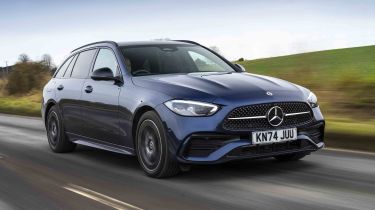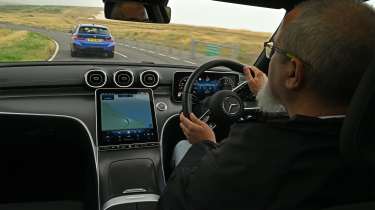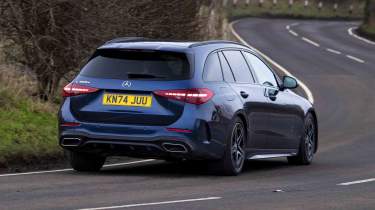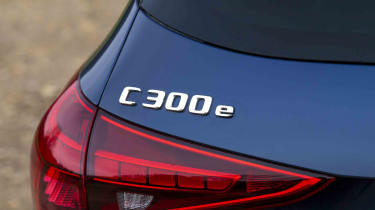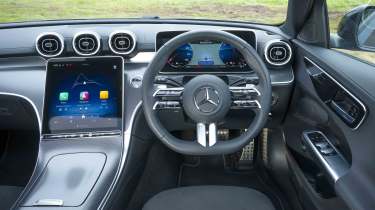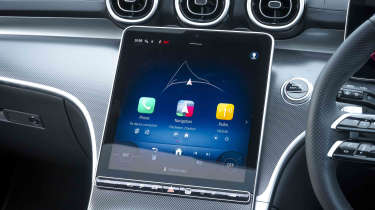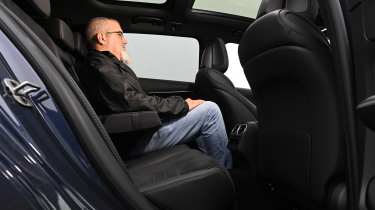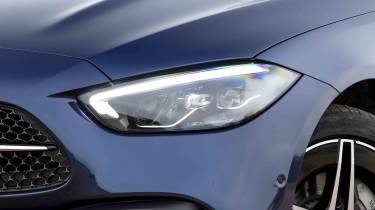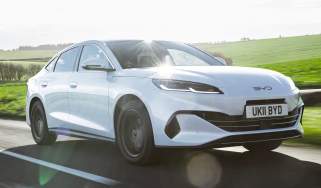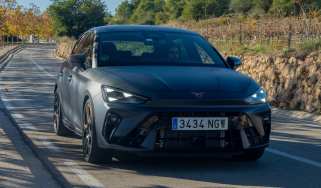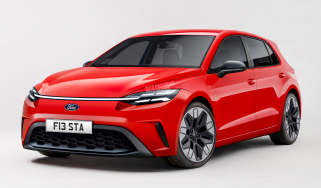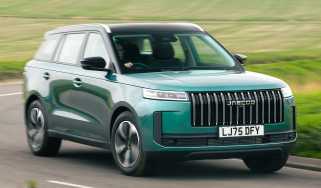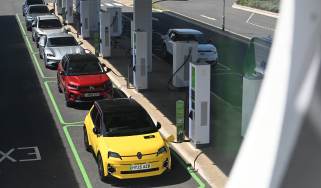Mercedes C-Class Estate review
The C-Class Estate is a great, albeit expensive option in the family estate genre with a strong selection of powertrains

Our opinion on the Mercedes C-Class Estate
There’s a premium appeal to the Mercedes C-Class Estate that makes it a worthy option, especially in a rapidly dwindling segment. The interior feels like a special place to be with quality materials and a real eye-catching design that helps it become a distinct proposition from its usual German rivals. The level of on-board technology is strong, as you’d expect of a Mercedes, but not every aspect of it has been implemented smoothly.
The driving experience matches the saloon, which is to say the estate rides beautifully and has just enough dynamism to entertain. Boot space is a bit of a let-down however - the mild-hybrids just about manage to be competitive and despite great electric-only range, the PHEV’s significant loss in capacity makes it a tough sell.
About the Mercedes C-Class Estate
The Estate version of the Mercedes C-Class first arrived in 1993 to replace the 190E and now Mercedes is on to its fifth generation, known internally as the W206, which arrived in 2021.
Mirroring the C-Class saloon’s trim level range, the estate’s is rather exhaustive. The C 200 petrol kicks things off, followed by the C 220 d diesel. Then there’s the C 300 petrol and the C 300 e petrol plug-in hybrid, which also comes in ‘de’ diesel form. The Mercedes-AMG versions sit at the top with the C 43 and the C 63 plug-in hybrid. Every C-Class comes with a nine-speed automatic gearbox.
Used - available now

2019 Mercedes
C Class
47,412 milesManualDiesel1.6L
Cash £15,532
2018 Mercedes
C Class
61,144 milesAutomaticPetrol2.0L
Cash £13,345
2019 Mercedes
C Class
34,646 milesAutomaticPetrol1.5L
Cash £17,659
2021 Mercedes
C Class
40,996 milesAutomaticDiesel2.0L
Cash £20,926We’ve pitched the C-Class Estate against its long-time rival the BMW 3 Series Touring (both in plug-in hybrid guise) and the BMW just about came out on top thanks to superior practicality. We also tested the C-Class Estate diesel against the plug-in hybrid 3 Series and all-electric Hyundai Ioniq 5 in a powertrain showdown - though the Mercedes came last in there.
Mercedes C-Class Estate prices and latest deals
The Mercedes C-Class saloon starts from around £46,000 with the Estate starting at around £1,800 extra. For the Estate’s extra practicality, you’ll pay roughly around that premium right the way through the trim level range too, up to the Mercedes-AMG C 63 S e Performance Night Edition Premium Plus Estate at around £102,000.
Depending on the engine you get a choice of several trim levels on the C-Class Estate. There’s the AMG Line, AMG Line Premium, AMG Line Premium Plus and solely reserved for the plug-in hybrids, the Urban Edition. Each of the trim levels adds around £2,500 to the price.
While the current C-Class Estate only arrived a few years ago, you can pick one up for almost half price on the Auto Express Buy A Car service with cars from around £25,000.
Performance & driving experience
Pros |
|
Cons |
|
With a range of petrol and diesel engines both featuring mild-hybrid or plug-in hybrid assistance, the depth of strength in the C-Class’ powertrains is impressive, even if there isn’t an all-electric alternative to tackle the still fledgling electric estate class.
Comfort is the order of the day with the C-Class, but we can also say this is the most dynamic compact executive estate from Mercedes with good levels of grip and overall balance.
| Model | Power | 0-62mph | Top speed |
| Mercedes C 200 d Estate | 197bhp | 7.6 seconds | 149mph |
| Mercedes-AMG C 63 E Performance Estate | 671bhp | 3.4 seconds | 155mph |
Performance, 0-60mph acceleration and top speed
The C 200 kicks off with the 1.5-litre four-cylinder petrol with 201bhp, the more powerful 2.0-litre petrol four-cylinder in the C 300 puts out 254bhp. As for the 2.0-litre four-cylinder diesels, the engine in the C 220 d provides 197bhp and the C 300 d 261bhp. The plug-in hybrid has even more power thanks to a 128bhp electric motor supplementing a 2.0-litre four-cylinder petrol, with a total of 309bhp.
The diesels are much improved over the old 2.1-litre you got in the previous C-Class - especially in terms of refinement. The C 220 d’s 440Nm of torque ensures you’ve got ample grunt, and it’s delivered low in the rev range, making the C 300 d seem a little unnecessary.
The petrol C-Class models appeal thanks to their smooth integration of mild-hybrid power to make up for the lack of torque compared to the diesels and their relatively smooth power delivery. Of the non-AMG models, you’ll typically find the gearbox to be a limiting factor in terms of engagement - it’s very much set up to provide seamless shifting, even in the ‘Sport’ driving mode.
While previous AMG-fettled C-Class generations have used V6s and V8s, the four-cylinders continue in the C 43 and C 63 estates - making sure Mercedes has a rival to the BMW M3 Touring and Audi RS 4 Avant. The C 43’s turbocharged four-pot is derived from the A 45 S hot hatch and provides a meaty 402bhp with the C 63 producing a supercar-baiting 671bhp from its plug-in hybrid powertrain with both coming with Mercedes’ 4MATIC all-wheel drive system. We’ve not driven the C 63 in estate form yet, though given it already weighs two tonnes, we expect the extra kerb weight of the estate won’t dilute the experience much.
Town driving, visibility and parking
The current C-Class Estate, like the saloon, offers decent all-around visibility so while it’s larger than its predecessor, it’s not a hassle to drive around town.
Smooth, near-silent running is offered by the C 300 e PHEV when the battery is fully charged, while light controls and decent responses mean it’s easy to drive at urban speeds. What also makes the C-Class Estate friendly around built-up areas is its 11-metre turning circle – which is tighter than either the BMW 3 Series and Audi A5 Avant. There’s optional rear-axle steering too, which reduces the turning circle to a supermini-like 10.64 metres.
The suspension is on the soft side for all non-AMG C-Class models, but if you really want to tap into the Mercedes ride comfort, go for the 18-inch alloy wheels that are fitted as standard across the line-up. The plug-in hybrid models also benefit from standard-fit air suspension on the rear axle, which really makes a difference at low speeds.
Country road driving and handling
Full-fat C 63 aside, with such a wide array of engines to choose from, you’d think the C-Class Estate would offer varied driving experiences from the base C 200 petrol up to the more powerful plug-in hybrids.
The non-AMG cars all have decent weight to their steering and it’ll take a lot to get them unstuck, but they still don’t offer the same enthusiasm in the corners as a BMW 3 Series.
The C 200 petrol has a kerb weight of 1,765kg and the C 300 e plug-in hybrid 2,120kg, but in truth, every C-Class Estate feels a little bit on the portly side. This is largely down to the suspension, which Mercedes has clearly (and refreshingly) tuned to soak up bumps and ruts in the road over cornering stability.
Motorway driving and long-distance comfort
The motorway is where the C-Class Estate really comes into its own, wafting along with almost S-Class-levels of serenity. It tackles undulations in the road exceptionally well, while wind and road noise are kept low.
The mild-hybrid engines are nicely subdued at speed and for the PHEVs, as long as there’s enough charge in the battery, the C 300 e will drive on electricity alone even at motorway speeds, but the refined nature of the cabin means that the engine is barely heard when it does finally cut in.
We have a few reservations about some of the driver-assistance tech that’s included with the C-Class Estate. Predictive cruise control is available, and even if a speed hasn’t been set, the system uses cameras and navigation data to help adjust the car’s speed to prevailing speed limits and surrounding traffic. It can be a little disconcerting to have the car slow down without any input, although it makes for a smooth drive if you can get used to it.
“I spent 10 hours driving up and down the country in the plug-in hybrid petrol and came out the other side feeling surprisingly fresh. The seats in the Mercedes are excellent with a good level of electric adjustment.” - Alastair Crooks, Senior News Reporter.
MPG & running costs
Pros |
|
Cons |
|
The C-Class Estate boasts pretty impressive efficiency figures and despite the extra weight compared with the saloon, you’ll barely notice the difference at the pumps.
The entry-level C 200’s 43.5mpg claimed figure and its CO2 emissions of 147g/km are better than you’d get from a BMW 320i Touring or the latest Audi A5 Avant. The more powerful C 300 is only a little thirstier at 41mpg while emitting 157g/km. The diesels see the C 220 d claiming 60.2mpg with an emissions figure of 123g/km and the C 300 d doing 53.3mpg on a combined cycle with 139g/km – pretty impressive numbers. During our time with the C 220 d we found no problem reaching high 50s for mpg.
If you’re looking for the most frugal C-Class Estate then the plug-in hybrid will be the one for you. The C 300 e Estate’s has a rather ridiculous 166.2mpg claim which obviously requires you to use electric-only running - though we’ve found this to drop to 40 miles in cold conditions. Without the battery charged up, you’ll see mpg figures in the mid 30s for both PHEV models.
| Model | MPG | CO2 | Insurance group |
| Mercedes C-Class Estate C 300 de | 166.2mpg | 45g/km | 43 |
| Mercedes C-Class Estate C 43 | 30.4mpg | 214g/km | 42 |
| Mercedes C-Class Estate C 300 d | 54.4mpg | 136g/km | 41 |
Electric range, battery life and charge time
Using the same size battery, you almost get the exact same electric range in the petrol C 300 e and the diesel C 300 de. Either way, they offer slightly more than the BMW 330e (59 miles) or the Audi A5 Avant (66 miles).
The Mercedes C-Class Estate doesn’t have dedicated space for charging cables, even though you get a cable with a 11kW capacity.
The C 63 e PHEV comes with electric-only running too, but the plug-in hybrid system for the AMG is very much focused on performance considering its measly seven-mile range.
| Model | Battery size | Range | Insurance group |
| Mercedes C-Class Estate C 300 de | 19.5kWh | 69 miles | 43 |
| Mercedes C-Class Estate C 300 e | 19.5kWh | 68 miles | 43 |
Insurance groups
Insurance on the Mercedes C-Class Estate will likely be higher than either the Audi A5 Avant or the BMW 3 Series Touring because it starts in group 33 for the base C 200, whereas the Audi starts in group 24 and the BMW group 29. The most expensive to insure is, unsurprisingly, the C 63, which sits in group 49.
Tax
Since the cheapest Mercedes C-Class Estate starts over £47,000, there’s no escape from the luxury car tax surcharge - meaning that after the first year, all models are subject to five years at £620 before dropping down to the standard £195.
For company car buyers, the CO2 emissions of the plug-in hybrid petrol (52g/km) means it just about sits out of the 1 to 50g/km band, despite its impressive electric range. This means it’s in the 16 per cent BiK tax band while the diesel PHEV is at nine per cent.
Depreciation
On average, the C-Class Estate will retain 43.4 per cent of its value after three years and 36,000 miles, the saloon however scores better at 45.1 per cent.
Like the saloon the C-Class Estate’s residual values differ noticeably depending on the powertrain. The C 300 e retains 45 per cent while the C 43 just 40 per cent.
Interior, design & technology
Pros |
|
Cons |
|
There’s an evolutionary appearance to the C-Class, while constantly increasing dimensions mean unfamiliar buyers could easily mistake it for the larger E-Class.
Interior and dashboard design
While Mercedes’ design language is somewhat identikit between its models, handsome looks are a defining feature across the board, the company’s cabins are among the most upmarket that you can find and it’s no different in the C-Class.
The interior layout might be a little brash for some. The days of understated Mercedes design seem well and truly behind us, but the overall layout in the C-Class Estate is neat and passengers will surely find it an impressive cabin to be in.
A high-set centre console with a large touchscreen at its head has become a trademark look for all of Mercedes’ interiors in recent years and helps give you a cocooned feel. Like the saloon, the estate gets a 12.3-inch digital driver’s display and a trio of metallic-finished air vents in the middle of the dashboard.
There’s a good selection of kit in the entry-level AMG Line with Mercedes’ Artico faux leather upholstery is lovely on the sports seats, with ambient lighting and a metal weave trim on the centre console all helping to deliver a luxurious cabin. The mix of silver and black might feel a bit solemn so again, it’s worth exploring the no-cost option of white and black or brown and black.
The high-spec AMG Line Premium Plus receives 19-inch alloy wheels instead of the 18-inch rims you get on lesser variants - but the AMG Line body kit is a staple throughout. Inside you’ll find the same level of quality, but with some quality additions like the open-pore wooden dash.
Materials and build quality
Those air vents feel great to use, with a smooth action and a precise click when moving them from open to closed. The metal paddle-shifters behind the steering wheel also feel upmarket, but the shortcut bar below the main touchscreen feels a little flexible to the touch, because the whole row of buttons moves as you select a function.
Generally, there are plush materials used throughout the C-Class Estate – we did find some movement or creaking low-down on the centre console, but there’s nothing to grumble about on a daily basis.
Infotainment, sat-nav and stereo
We’re fans of the Mercedes MBUX infotainment system because it manages to look like a premium set up while maintaining a degree of simplicity and ergonomic straightforwardness to it. The big portrait screen on the dash features a wonderfully clear resolution and while the initial menu layout might look intimidating at first glance with a few intricate-looking icons to navigate, you’ll soon get to grips with it. It’s also quick to respond to inputs, and loading times are kept to a minimum even when scrolling through the many sub-menus.
The 12.3-inch driver’s display is more of the same - there’s a customisable setting with modes like ‘Classic’ or ‘Sport’ depending on what information you want to prioritise. The integrated Mercedes sat-nav is excellent, with a clear display and sensibly laid-out functionality.
We don’t like the touch-sensitive buttons on the steering wheel. They’re just too fiddly for their operation and we sometimes accidentally changed the volume or turned audio off just by brushing our hands against it.
Speaking to your car to change settings is still an alien concept to UK buyers. But if you’re happy to ‘talk to yourself’, then it can be an easy way to bypass distracting use of the touchscreen. In the C-Class, simply say “Hey Mercedes” and the system activates." - Dean Gibson, Senior test editor.
Boot space & practicality
Pros |
|
Cons |
|
The Mercedes sits between its German rivals for exterior size and as a result it’s neither the worst nor the best for interior space. There are plenty of family-friendly practical features inside the C-Class Estate however.
| Dimensions comparison | |||
| Model | Mercedes C-Class Estate | BMW 3 Series Touring | Audi A5 Avant |
| Length | 4,793mm | 4,713mm | 4,829mm |
| Width | 1,820mm | 1,827mm | 1,860mm |
| Height | 1,462mm | 1,448mm | 1,460mm |
| Wheelbase | 2,865mm | 2,851mm | 2,902mm |
| Boot space | 360/490 litres | 410/500 litres | 476 litres |
Seats & passenger space
Like the saloon, the Mercedes C-Class Estate’s practicality isn’t class-leading, but it’s still competitive. The cabin space is easily big enough for adults to get comfortable up front or in the rear, with a generally decent amount of all-round visibility no matter where you sit.
The driving position is spot on with plenty of adjustability in the electrically-operated seat to get comfortable. There’s a sliding lid for the centre console’s phone storage and cupholders, and on the armrest, there’s enough space to fit a small bag - we like the split-opening function too. There are two easily-reachable ISOFIX mount points on the outer rear seats. The rear bench also folds in a 40/20/40 so there’s a lot of adjustment for space too.
Boot space
The boot of the mild-hybrid C-Class Estates are pretty competitive, but unfortunately for the plug-in hybrid versions there’s a battery behind the rear seats which encroaches on the boot space and shrinks noticeably. It’s a high boot floor as a result, but still a usable size for most families – and indeed dogs. High-spec versions of the Skoda Octavia Estate might be worth a look if boot space is particularly important, given the Czech car’s 640-litre capacity.
Towing
Like the saloon, all C-Class Estate models have a braked towing capacity of 1,800kg, which should be more than enough for most. If you need a greater towing capacity then you may want to consider the E-Class, which tops out at 2,100kg.
“Space is good in the back of the Mercedes, though it’s a bit barren back there with air vents and fold-down cupholders the only real luxury features for rear passengers.” – Alastair Crooks, Senior News Reporter.
Reliability & safety
Pros |
|
Cons |
|
The C-Class, in both saloon and estate forms, received a full five-star rating from Euro NCAP when tested in 2022. There’s a range of standard safety technology like blind spot monitoring, lane-keep assistance and autonomous braking, which resulted in a good score in the safety assist category. Adult and child occupant crash safety scores were even better, so you should rest easy in the knowledge that the C-Class Estate will stand up well to impacts.
Mercedes doesn’t give away all its safety technology for free however. The Driving Assistance Package Plus is an option at around £1,700 and adds ‘Pre-Safe’, which adjusts the seat to protect against side impact and ‘Distronic’ which regulates the speed to the car ahead – from motorway speeds to slow-moving traffic.
The cheapest level of service plan for a C-Class Estate that does 12,000 miles a year on average is £42 a month for the first three years. This includes three services and an MoT.
The Mercedes brand came second in the 2025 Driver Power best brands survey after coming a disappointing 25th place in 2024.
That turnaround is thanks to the brand’s performance in the latest best cars to own survey. The C-Class came a very impressive fifth with the Mercedes GLE coming in at top spot and the A-Class reaching a commendable 11th.
C-Class buyers were particularly impressed by the car’s engine and gearbox as well as the digital matrix headlights and MBUX infotainment. Value was another area where the C-Class scored well.
| Euro NCAP safety ratings | |
| Euro NCAP safety rating | Five stars (out of five) |
| Adult occupant protection | 93% |
| Child occupant protection | 89% |
| Vulnerable road user protection | 80% |
| Safety assist | 82% |
Buying and owning
- Best buy: Mercedes C-Class Estate C 220 d AMG Line
As diesel estates go, the C 220 d is tough to beat. The C-Class Estate offers some great engines and the plug-in hybrids are impressive, but for day-to-day performance and efficiency, the 2.0-litre turbocharged four-cylinder is all you’ll really need. The AMG Line comes on the smaller wheels to give you the C-Class’ best ride quality while saving you £3,000.
Mercedes C-Class Estate alternatives
Buyers might be preferring mid-size SUVs to family-friendly estate cars these days, but there’s still plenty of competition to the Mercedes C-Class Estate. There is, of course, the BMW 3 Series Touring, which not only provides a more compelling drive, but now comes in BMW M3 Touring guise for those wishing for a truly exciting experience. Then there’s the Audi A5 Avant (which replaces the previous generation Audi A4 Avant), which still looks just as appealing as ever. There are also high-spec versions of the Volkswagen Passat - which you can only get as an estate and even electric cars are starting to get into the estate genre, with the Volkswagen ID.7 Tourer providing a genuine zero-emissions alternative.
Frequently Asked Questions
We like the Mercedes C-Class Estate’s style, ride and engine line up. It’s a practical family car too that feels worthy of the Mercedes badge.

